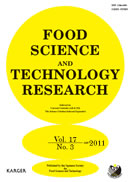Volume 17, Issue 3
Displaying 1-11 of 11 articles from this issue
- |<
- <
- 1
- >
- >|
Food Technology and Engineering
Original paper
-
2011Volume 17Issue 3 Pages 179-186
Published: 2011
Released on J-STAGE: August 10, 2011
Download PDF (250K)
Technical paper
-
2011Volume 17Issue 3 Pages 187-198
Published: 2011
Released on J-STAGE: August 10, 2011
Download PDF (799K)
Note
-
2011Volume 17Issue 3 Pages 199-202
Published: 2011
Released on J-STAGE: August 10, 2011
Download PDF (339K)
Food Science and Chemistry
Original papers
-
2011Volume 17Issue 3 Pages 203-208
Published: 2011
Released on J-STAGE: August 10, 2011
Download PDF (211K) -
2011Volume 17Issue 3 Pages 209-218
Published: 2011
Released on J-STAGE: August 10, 2011
Download PDF (1021K) -
2011Volume 17Issue 3 Pages 219-226
Published: 2011
Released on J-STAGE: August 10, 2011
Download PDF (276K) -
2011Volume 17Issue 3 Pages 227-232
Published: 2011
Released on J-STAGE: August 10, 2011
Download PDF (214K) -
2011Volume 17Issue 3 Pages 233-240
Published: 2011
Released on J-STAGE: August 10, 2011
Download PDF (541K) -
2011Volume 17Issue 3 Pages 241-250
Published: 2011
Released on J-STAGE: August 10, 2011
Download PDF (505K) -
2011Volume 17Issue 3 Pages 251-256
Published: 2011
Released on J-STAGE: August 10, 2011
Download PDF (559K) -
2011Volume 17Issue 3 Pages 257-266
Published: 2011
Released on J-STAGE: August 10, 2011
Download PDF (448K)
- |<
- <
- 1
- >
- >|
